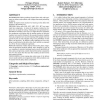Free Online Productivity Tools
i2Speak
i2Symbol
i2OCR
iTex2Img
iWeb2Print
iWeb2Shot
i2Type
iPdf2Split
iPdf2Merge
i2Bopomofo
i2Arabic
i2Style
i2Image
i2PDF
iLatex2Rtf
Sci2ools
PROMISE
2010
2010
On the value of learning from defect dense components for software defect prediction
BACKGROUND: Defect predictors learned from static code measures can isolate code modules with a higher than usual probability of defects. AIMS: To improve those learners by focusing on the defect-rich portions of the training sets. METHOD: Defect data CM1, KC1, MC1, PC1, PC3 was separated into components. A subset of the projects (selected at random) were set aside for testing. Training sets were generated for a NaiveBayes classifier in two ways. In sample the dense treatment, the components with higher than the median number of defective modules were used for training. In the standard treatment, modules from any component were used for training. Both samples were run against the test set and evaluated using recall, probability of false alarm, and precision. In addition, under sampling and over sampling was performed on the defect data. Each method was repeated in a 10-by-10 cross-validation experiment. RESULTS: Prediction models learned from defect dense components out-performed stan...
| Added | 20 May 2011 |
| Updated | 20 May 2011 |
| Type | Journal |
| Year | 2010 |
| Where | PROMISE |
| Authors | Hongyu Zhang, Adam Nelson, Tim Menzies |
Comments (0)

